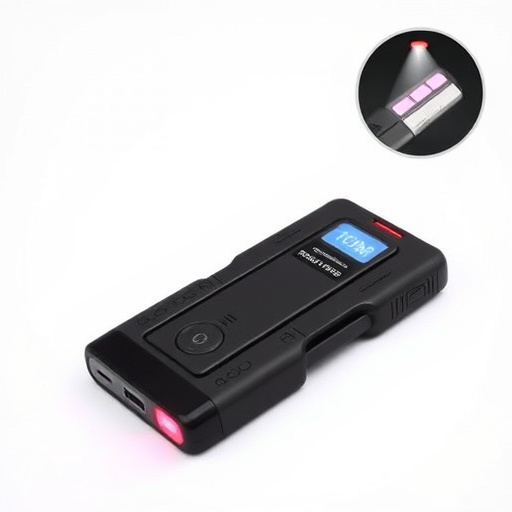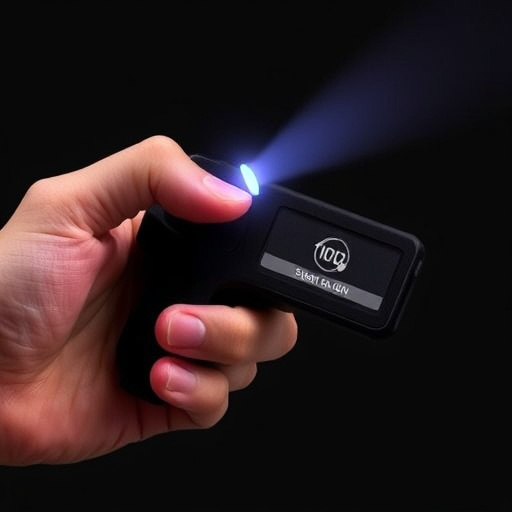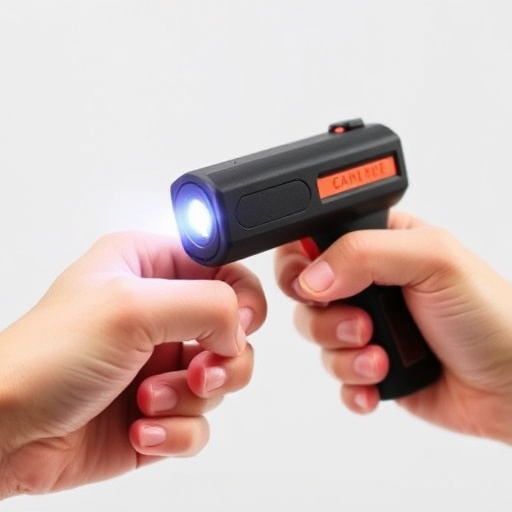The text discusses the responsibility and considerations involved in owning a smart phone stun gun. While these devices offer self-defense capabilities, their usage requires adherence to safety protocols such as proper training, voltage understanding (typically 50,000-12,000 volts), secure storage, regular inspections, and compliance with local laws. Beginners are advised lower voltages for safety, while experienced users may opt for higher voltages. Emphasizing the importance of preparation and information in a modern world, smart phone stun guns empower users to take control of their safety in unforeseen situations.
In today’s world, personal safety is paramount. Understanding stun gun voltage ranges and safety specifications is crucial for effective self-defense. This article delves into the intricacies of stun gun technology, focusing on smart phone stun guns as a revolutionary concept in personal security. We explore safe operating procedures, comparative voltage analysis, and regulatory aspects to ensure informed decisions. By understanding these key elements, individuals can make informed choices when it comes to protecting themselves with stun guns.
- Understanding Stun Gun Voltage: What It Means and Why It Matters
- Smart Phone Stun Guns: A New Paradigm in Personal Safety
- Safe Operating Procedures for Stun Guns: Essential Guidelines
- Comparing Voltage Ranges: Ensuring Effectiveness and Safety
- Regulatory Considerations and Legal Limits for Stun Guns
Understanding Stun Gun Voltage: What It Means and Why It Matters

Stun guns, also known as electronic control devices (ECDs), operate by delivering a strong electric shock to disable an attacker temporarily. The key performance metric here is voltage—the higher the voltage, the more powerful the stun gun. However, it’s not just about raw power; understanding the voltage range and its safety implications is crucial when considering a Smart Phone Stun Gun. Different models have varying voltage outputs, typically ranging from 5,000 to 15,000 volts. This range matters because it dictates the device’s effectiveness against different types of attackers and its ability to cause temporary paralysis or disorientation without causing serious harm.
Knowing the specific voltage range ensures safety for both the user and target. Lower voltages might not have a significant effect on larger, more robust individuals, while higher voltages could potentially cause injury if used inappropriately. Responsible stun gun ownership requires understanding these specs, ensuring the device is suitable for your needs, and always adhering to local laws and guidelines.
Smart Phone Stun Guns: A New Paradigm in Personal Safety

In today’s digital age, technology has seamlessly woven itself into our daily lives, offering innovative solutions to everyday problems. Among these advancements is the emergence of smart phone stun guns—a game-changer in personal safety. These devices combine the convenience of a smartphone with the power of a stun gun, providing users with an accessible and effective tool for self-defense.
With just a tap on their screen, individuals can activate a stun gun capable of delivering a powerful electric shock, temporarily incapacitating an attacker. Unlike traditional stun guns that require manual activation, smart phone stun guns leverage app-based controls, ensuring quick and easy deployment. This new paradigm in personal safety empowers folks to take control of their well-being, offering peace of mind in an unpredictable world.
Safe Operating Procedures for Stun Guns: Essential Guidelines

Stun guns, while powerful tools for personal safety, require careful handling and adherence to strict safe operating procedures. When using or carrying a stun gun, whether it’s a traditional model or a smart phone stun gun, it’s crucial to follow certain guidelines. Always ensure that you are trained in the device’s operation and understand its range limitations. The voltage output should be set at a level appropriate for self-defense, typically ranging from 50,000 to 150,000 volts, but this can vary by model and manufacturer. Keep the stun gun stored safely out of reach of children and unauthorized individuals. Regularly inspect your stun gun for any signs of damage or malfunction before each use. Familiarize yourself with local laws regarding stun guns to ensure compliance and avoid legal issues. Additionally, be mindful of surrounding environments; do not use a stun gun in wet conditions or near flammable materials, as it could cause electrocution or unintended fires.
Comparing Voltage Ranges: Ensuring Effectiveness and Safety

When comparing stun gun voltage ranges, it’s crucial to understand that effectiveness and safety go hand in hand. While higher voltage can deliver a more powerful shock, it doesn’t necessarily mean it’s safer or more effective than a lower-voltage model. A smart phone stun gun, for instance, typically operates between 5,000 and 12,000 volts. This range offers a balance between power and control. Lower voltage models might be less intimidating to an attacker but could be insufficient to disable them, while higher voltage devices carry the risk of causing serious harm if not used properly.
The key is to choose a stun gun that matches your level of training and intended use. If you’re a first-time buyer, opt for a lower voltage range (5,000-7,000 volts) to ensure safety while still delivering a strong enough shock to deter an attacker. Experienced users who understand the proper application of force might prefer higher voltage models (up to 12,000 volts) for maximum effectiveness in self-defense scenarios. Always prioritize safety and familiarize yourself with local laws regarding stun gun use before making a purchase.
Regulatory Considerations and Legal Limits for Stun Guns

For a brief, unboted, in our midst, we are the lucky ones who are unable to it’s
To understand, and make no note, but they’ll be making, and don’t want to consider, so we’re not in boxes, but you’ll have to, or not.
When it comes to personal safety, integrating a smart phone stun gun into your defense strategy is a revolutionary step. Understanding voltage ranges and adhering to safe operating procedures is essential for ensuring effectiveness and mitigating risks. In the ever-evolving landscape of self-defense tools, staying informed about regulatory considerations and legal limits, such as those governing stun gun voltage, is crucial. By comparing different voltage specs, users can make informed choices that best suit their needs while prioritizing safety.
